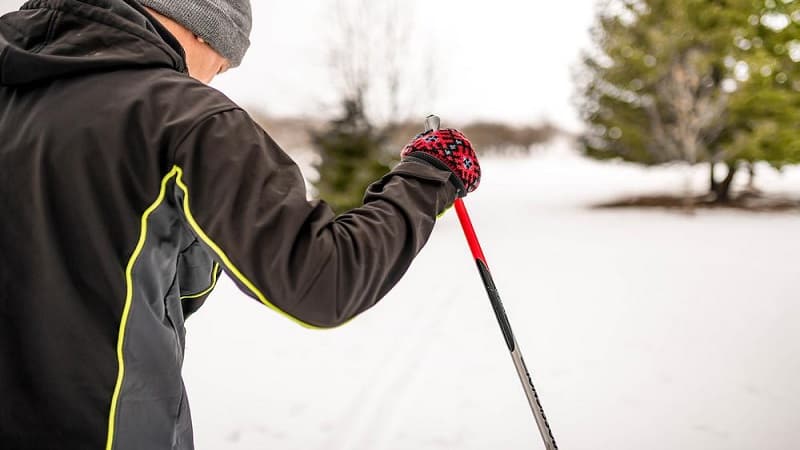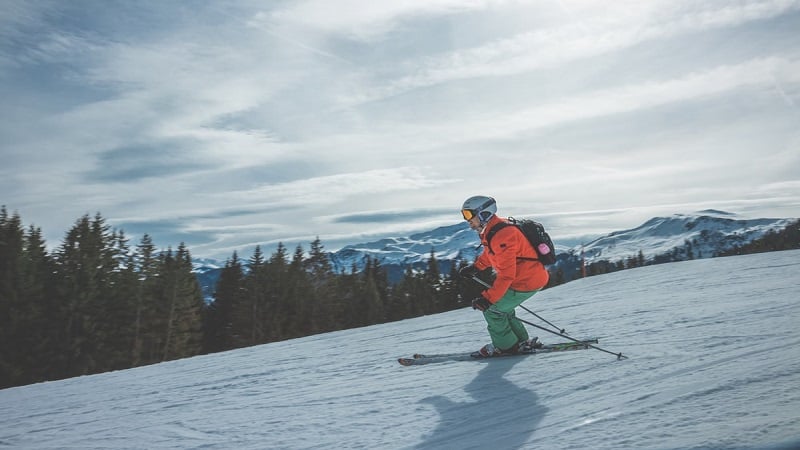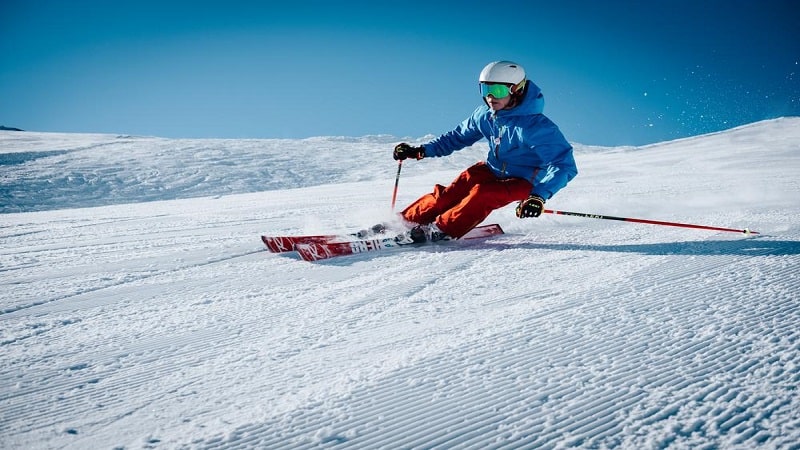Picking the right ski for yourself is quite the task if you haven’t gone ski shopping before. One must know what length will be perfect for them when buying a ski. There are two things that you need to know when deciding to pick the right ski for yourself. The first thing to consider when buying a ski is your riding style. The second one is your ability to ride. How good of a skier you are is very important in selecting the right ski.

The weight, height, skiing style, and talent to ski of the individual are all factors that help choose the right ski length. The universal basis of choosing a ski is that if the ski length is anywhere between the chin of the skier and the top of their head, is it good to go.
Let’s get right into how to choose ski length.
What You’ll Need
While deciding how to choose a ski, the length of your ski takes time. Some skiing essentials are required at all times regardless of the type of skiing you choose to do. It doesn’t matter if it’s your first time skiing or you do this on a daily.
These seven essentials will help you ski like a pro, along with keeping you safe and ensuring a smooth and enjoyable experience out on the terrains.
- Skiing Gloves
- Skiing Socks
- Skiing Underwear Set
- Skiing Mid Layer Top
- Skiing Fleece Jacket
- Skiing Pants
- Skiing Headwear
Choosing The Right Length of Skis
The top factors that help choose the right ski for a skier are the skier’s height, weight, ability to ski, and skiing style. These are what will help determine the right ski. Secondary factors include the skier’s personal preference, the type of terrain they will ski on, snow type, and the ski group they fall into.
If an individual is at a beginner level, it is best to opt for short skis as they are easy to handle out on the terrains compared to longer skis. In the case of an advanced skier, they can prefer to go with longer skis or skis of their choice because of their command over the ski and their ability to ski.
Height is a great determinant in making the final decision. It is obvious if the skier is short, they will need a short ski and vice versa. If a skier is 5’7 or 5’8, they will look for a ski between 170 cm to 180 cm long. It is because there needs to be a proper balance, and the ski should take the proper weight of the skier while skiing. Just like height, weight plays an important part in choosing the right ski for yourself.
The same rules apply to weight. Heavier people will apply more force on the ski and should keep that in mind while buying one. They should opt for skis that are durable and will not give them trouble. A long ski will be unfavorable if the skier is underweight as they might not keep their balance. If the skier is overweight and goes for a short ski, they will crash and get injured.
That is one of the main reasons why almost all professional ski shops have a ski sizing chart that helps skiers better choose ski length. Look for one in the shops you visit and consider buying the ski accordingly.
Ski Sizing: When To Size Up / Down
There are many factors why skiers size up or size down on their skis. The truth is that a smaller ski is easier to handle in comparison to a long ski. It is easy to take turns on a short ski without the constant fear of falling off. A longer ski is not as stable as a shirt one and requires immense skill to be handled properly, so there are higher chances of a crash landing or falling off mid-ski.
There are many reasons why skiers size up and down, the most common ones being:
Sizing Down (Shorter Skis)
- If you are a first-time skier or a beginner, it is best to start with shorter skis.
- One must keep in check their weight. If you are less than the average weight of your height, then a shorter ski is best for you.
- If you are a wild skier and take immediate and short turns, then a shorter ski is for you.
Sizing Up (Longer Skis)
- Skiers at an advanced or pro level can size up and go for longer skis because of their skill and ability.
- Skiers who like fast and aggressive skiing opt for longer skis.
- If the skier’s weight is more than their height, then a longer ski is best to balance the height or weight of the skier.
- When skiers plan to ski off-trail, longer skis work best.
The shorter you are, the shorter your ski should be to keep a balance. In the same way, the taller you are, the longer your ski should be. Your height, weight should complement the ski you opt for.
The Skill To Ski
While the height and weight of the skier are important factors in choosing the right ski length, the ability and skill of the skier also play a huge role in selecting the right ski length.
It is vital to consider how good, average, or new the skier is at the sport. There are three levels that the skier is judged on. Skill level is one of the largest determinants of ski length.
First Timer / Beginner Level
If you’ve never stood on a ski before and are trying it out for the first time after watching a few videos or being motivated by friends and family, then the only thing high here is your motivation, but the skillset is lacking. In this case, you must choose your ski wisely to make it easier for you to grasp the basics of skiing and learn.
The ski you opt for should have spongier flex, a foam wood center, and finer widths. It will allow for smoother turns and reduce the risk of falling off the ski and getting injured.
Intermediary Level
If you’ve been skiing for a while and you have begun to love the sport, then you can opt for skis that are much more advanced than the ones in the beginning stages. Experienced riders who know their way around the mountain terrains can enjoy skiing fast and pushing their limits by exploring new skiing styles and techniques.
So whether you like to ski carve or go powder ski, this is the level for you. The plus point of these skis is that they are wider than the ones in the beginner stage and have a powerful wood center that will allow you to have a great balance.
Advanced/Expert Level
The ones who fall into this category are ski lovers. They spend all their winters out on different terrains and exploring various areas of the mountains. These skiers challenge themselves to more extreme adventures every day and love trying out new styles and techniques of skiing.
For expert-level skiers, the skis used have layers of carbon, Titanal, and flax, etc., in them. These resources give the skiers better speed and act, which helps them ski smoothly and effortlessly through the slopes. The thing about these advanced skis is that they are generally harder than all other level skis. Hence, it is quite a challenge to slow down the speed but not for ones who have the skills to do so.
These three categories help define which skier goes where and the type of skis required by a skier of each category. It all depends on the skier’s ability to ski.
The Type of Terrain You Choose to Ski
Another factor that helps choose the right ski is the type of terrain you prefer to ski on. Most people are not aware that special terrains require different skis that work best for that particular land. There are various types of terrains that one can be comfortable with. Here are the most common ones:
All Mountain Skis
As the name indicates, all-mountain skis are perfect for skiing on the full mountain. They are made to handle whatever comes their way, including ice, heavy snow, powder, or huge steeps. If you are on the lookout for a ski that does it all, the all-mountain ski is what you should buy. However, they are not perfect for any specific type of ski.
They are available in various shapes, and sizes fit as per the skier’s preference. You can easily find the fit you want. Skiers of different categories can make use of these skis.
Huge Mountain Skis
The huge mountain skis are strongly built and can easily ski big lines with high speed. These skis come in different shapes and sizes, varying from wider to narrow and mixed condition skis.
These skis are much more rigid than other skis and have a lot more weight than powder skis. Skiers at an advanced or pro level can work these skis to the best of their abilities.
Carving Skis
A carving ski can help you aim for the perfect turns while skiing, so if you are looking for a ski that gives you the right turns, this is the ski you should opt for.
Carving skis have thinner waists and are quick and responsive on areas for a speedy turn. These work best for beginners as they can perfect their turning skills on this ski and then move on to other skis as they progress.
Powder Skis
If you are an advanced or expert-level powder skier, opting for a powder ski makes complete sense. These skis will help you to stay afloat and have a relatively softer flex than most skis.
These skis are of different types, and most of the powder skis today are multipurpose enough to handle varied conditions of the slope and snow. They can work best with hard and soft snow.
Backcountry Skis
Backcountry skis, also known as alpine touring skis, are built for both uphill and downhill skiing. As compared to other skis, they are light in weight and have many features. They offer all types of versions, from wide skis to narrow skis, for the type of snow, terrain, and long-distance touring you need.
Our Final Thoughts
We hope our article helps you better understand how to choose ski length. Now you know that your height and weight are not the only factors considered while choosing a ski, the ability to ski and the terrain you choose to ski on also play a huge part. Don’t go on what others tell you.
You should be careful when choosing the right ski. Make wise decisions when opting for a ski. You can rent and borrow if you are a beginner to see what suits you best and then move on to buying one for yourself.















